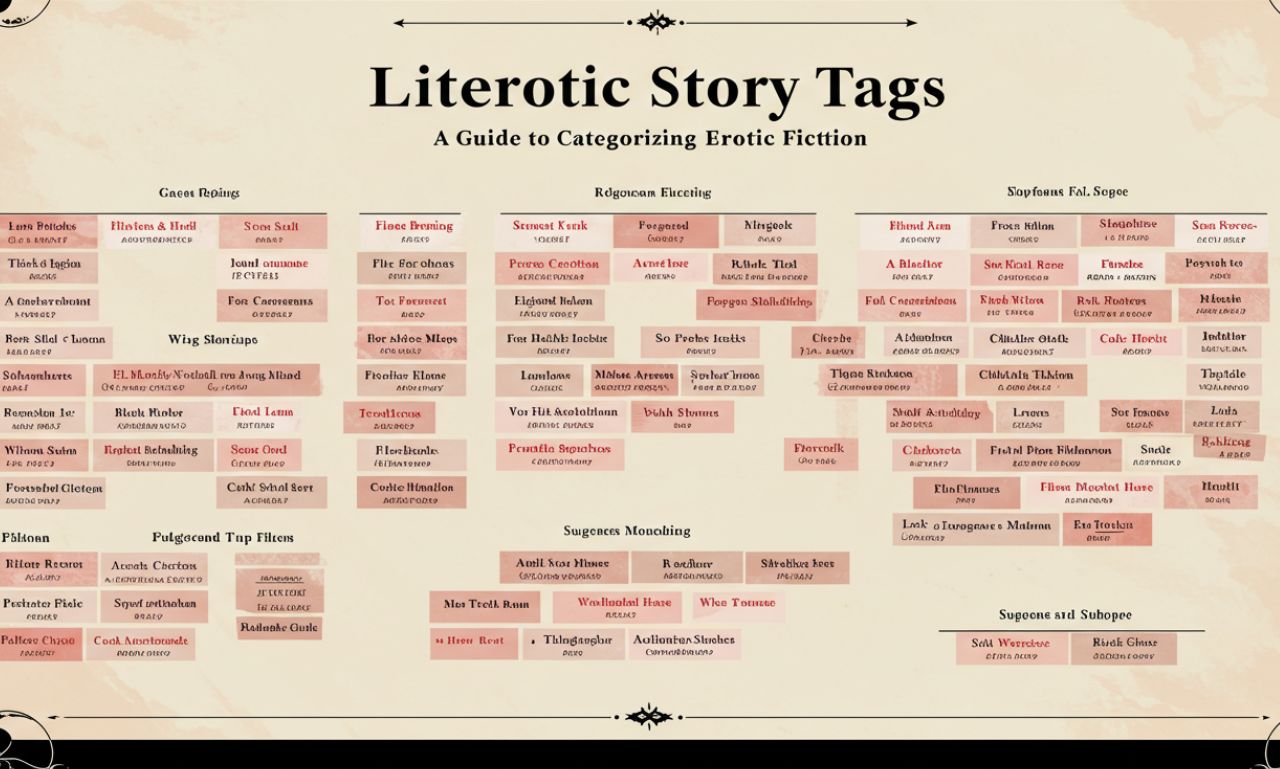In the expansive world of online erotic literature, the use of literotic story tags has become an essential tool for both writers and readers. These tags act as guideposts—helping readers discover stories aligned with their preferences, while assisting writers in reaching their intended audiences. Though often overlooked, tags offer far more than simple categorization; they reflect evolving sexual identities, preferences, and the diversity of storytelling itself.
Understanding Literotic Story Tags
Literotic story tags are keywords or short phrases attached to erotic stories that indicate the themes, sexual activities, characters, tone, or even content warnings. Much like hashtags on social media, they provide an instant snapshot of what to expect in a piece of writing.
These tags make it easier to:
-
Filter unwanted content
-
Discover niche interests
-
Navigate massive archives
-
Respect consent and trigger boundaries
Used effectively, literotic story tags enhance the reading experience and provide vital context in a genre where personal preferences vary widely.
The Purpose of Literotic Story Tags
Tags in erotic fiction are not just add-ons—they’re central to the story’s visibility and integrity. Here’s why they matter:
-
Discovery: Helps readers find stories aligned with their sexual orientation, fantasies, or emotional tone.
-
Safety: Alerts readers to potentially triggering or non-consensual content.
-
Clarity: Provides a preview of content before reading.
-
SEO & Visibility: Enhances how stories appear in search engines and within internal site filters.
Common Literotic Story Tags in Use
Some of the most used literotic story tags include:
-
MF, FF, MM: Gender-based pairings
-
BDSM: Covers kink and power dynamics
-
First Time: Characters experiencing a new situation
-
Taboo: May include step-relations, age gaps
-
Consensual Non-Consent (CNC): Fictional non-consensual scenarios with a safe storytelling lens
-
Voyeurism/Exhibitionism: Focus on watching or being watched
Each tag acts like a roadmap, ensuring that both casual browsers and dedicated readers can navigate content easily.
Tagging Based on Relationship Dynamics
Tags often highlight relationship types and emotional contexts:
-
Romantic Erotica: Focuses on emotional connection alongside physical intimacy
-
Casual Encounters: One-time flings or spontaneous scenarios
-
Polyamory & Group Sex: Includes MMF, FFM, and larger group variations
-
Cheating & Infidelity: Delves into betrayal, secrecy, or forbidden desire
These relationship tags help set expectations on emotional tone and interpersonal dynamics.
Tags That Indicate Consent and Ethical Content
Consent is a cornerstone in ethical erotica writing. Tags such as:
-
Consensual
-
Non-Con (Non-Consensual)
-
Dubcon (Dubious Consent)
-
CNC (Consensual Non-Consent)
These are especially important for giving readers agency over what they consume. Platforms often place such tags prominently to reinforce reader safety and informed exploration.
Fetish-Focused Literotic Story Tags
Erotic fiction dives deep into fetish territory, and tags allow users to engage or avoid these themes. Common fetish-related tags include:
-
Foot Fetish
-
Latex/Lingerie
-
Spanking
-
Breath Play
-
Public Play
-
Role Reversal
These tags help readers locate very specific desires, promoting both sexual exploration and awareness of boundaries.
Fantasy and Roleplay Themes in Literotic Story Tags
Tags also open doors to fantastical realms and roleplay scenarios:
-
Incubus/Succubus
-
Vampires/Werewolves
-
Teacher/Student
-
Boss/Employee
-
Stranger Encounters
-
Medieval Fantasy
Such themes blend fiction with sexuality, offering both escapism and creative inspiration.
Tagging Based on Story Structure or Style
Some literotic story tags relate to the form or tone of the writing:
-
Flash Fiction: Very short stories under 1000 words
-
Slow Burn: Erotic tension builds over time
-
Hardcore: Direct and explicit content
-
Softcore: Emphasizes sensuality over graphic details
-
Humor/Erotic Comedy: Blends laughter with lust
These structural tags help readers choose stories that match their preferred pacing and detail level.
The Role of Content Warnings as Tags
Beyond pleasure, story tags are used to warn about potentially distressing material:
-
Rape/Non-Con
-
Violence
-
Underage (Fictional, age regression)
-
Incest (usually taboo fantasy)
-
Drug Use
Platforms often regulate or flag these tags more strictly. While controversial, their inclusion empowers adult readers to make informed choices.
LGBTQ+ Literotic Story Tags
Modern platforms support inclusive tagging systems to represent diverse identities:
-
Trans MTF/FTM
-
Non-Binary
-
Bisexual
-
Pansexual
-
Genderfluid
These tags help uplift underrepresented voices and offer readers experiences that mirror their identity or curiosity.
Navigating Kinks and BDSM Tags
Kink communities often have nuanced preferences, so tagging is especially specific here:
-
Dom/Sub
-
Bondage
-
Impact Play
-
Service Submission
-
Pet Play
-
Shibari
Clear BDSM tagging supports consent culture and avoids accidental exposure to uncomfortable themes.
How Literotic Story Tags Aid Writers
For writers, tags offer:
-
Targeted Discovery: Appearing in niche searches improves visibility
-
Story Focus: Helps writers stay true to the themes they want to explore
-
Community Alignment: Aligning tags with popular or emerging themes builds readership
Good tagging is a form of self-marketing—authors who master it often grow faster.
Platform Guidelines and Tag Limitations
Different story-hosting platforms have varied rules around tagging:
-
Some limit the number of tags to 10–15
-
Others restrict certain explicit or violent tags
-
Community-driven sites like Literotica or Archive of Our Own (AO3) allow for more detailed customization
Understanding platform policy is essential for proper visibility and avoiding content bans.
Custom vs. Standard Tags
While standard tags (like BDSM or FF) are universally understood, custom tags allow creative freedom:
-
“Naked Hiking in Iceland” or
-
“Cursed Pleasure Mirror”
These tags hint at plot elements or moods, acting like micro-summaries. However, overuse of custom tags can lead to disorganization.
Reader Behavior and Tag
Studies and feedback from platforms suggest:
-
Shorter tags increase engagement
-
Highly specific tags draw niche readers
-
General tags like “erotica” or “romance” get high traffic but low conversion
-
Tags used in combination (e.g., “FF + Vampire + Slow Burn”) provide the best match
Smart tagging results in better story-to-reader alignment.
Improving Discoverability with Tags
To boost story visibility, consider:
-
Using high-traffic, relevant tags
-
Including at least one content warning tag (when necessary)
-
Choosing tags that match story tone and resolution
-
Avoiding misleading tags—these hurt credibility
The Future of Literotic Story Tags
The landscape of literotic story tags is constantly evolving with new terminologies, identities, and kinks. Future trends point to:
-
AI-assisted tagging systems
-
Reader-driven tag suggestions
-
Tag moderation bots to prevent misuse
-
Personalized tag-based recommendations
These developments aim to make content filtering more accurate and user-centric.
Conclusion
Literotic story tags are much more than metadata—they’re crucial to consent, clarity, and connection in the world of erotic fiction. Whether you’re a seasoned writer or an eager reader, understanding how to use, interpret, and benefit from story tags transforms how you engage with erotica online. In a genre driven by diversity, fantasy, and personal taste, effective tagging is the invisible thread that brings it all together.

